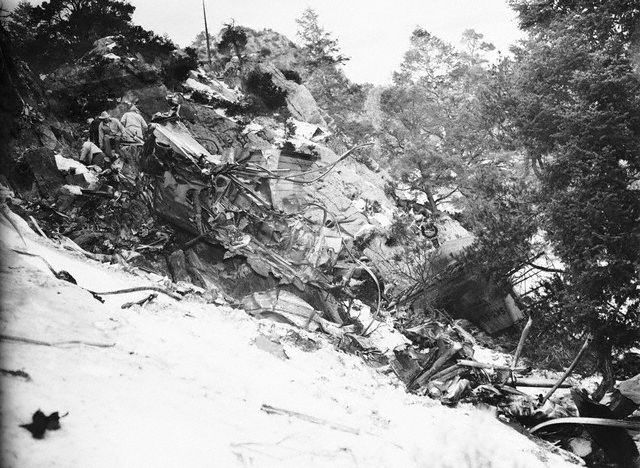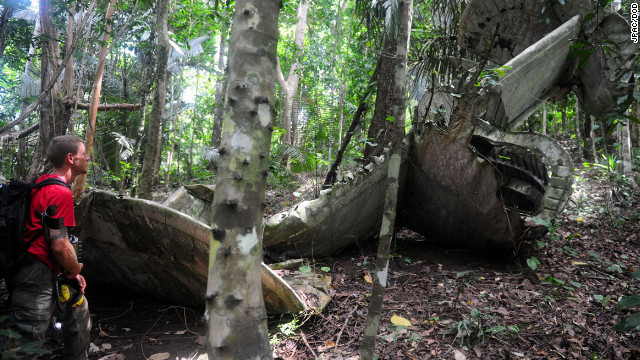
Within a few hundred yards of the top of Double Up Peak, 11 miles north of Goodsprings, Nevada, a doughty band of six searchers found the missing TWA plane which crashed at 7:30 last evening, carrying movie star Carole Lombard and 15 army pilots to their death.
The ship apparently failed to clear the crest by a short distance, crashed and fell back down the mountainside some 450 yards, where it was found in three feet of snow at 10:30 this morning by searchers who went in from Goodsprings.
The party was led in by Lyle Van Gordon, former high school football star, who saw the crash last night and the subsequent fire, marked the spot and was waiting for the group when it arrived early this morning from Las Vegas.
Deputy Sheriff Jack Moore, Robert B. Griffith, George Bondley, Jack Hart and Otto Swartz comprised the party, which left at daybreak on foot and climbed straight up the mountain to the scene of the tragedy.
They spent only a short time there, left Hart and Bondley to guard the wreckage and returned to Las Vegas to report their findings and organize a party to return and bring out the bodies.
The 19 passengers aboard and members of the crew were apparently all instantly killed, their bodies strewn over an area several hundred yards in diameter. The ship was completely demolished.
There was no theory at all as to the possible cause of the disaster, for the pilot apparently flew into the mountain which is only 7,500 feet in height and nothing of an obstacle to the big Douglas transport ship.
The army pilots aboard were returning from Albuquerque (N.M.), where they had just ferried several planes to the new bomber base.
Miss Lombard, her mother and press agent were returning to Hollywood after a trip to Indianapolis to open a drive for the sale of defense bonds.
The Goodsprings party was the only one operating from that side of the mountain but there were more than 100 searchers on the Blue Diamond side.
Immediately rescue crews were organized in Las Vegas, ambulances were sent out, army officers and soldiers, sheriff’s deputies, police officers, firemen and volunteers started out, warmly dressed for the long hard search over the rough terrain.
Clem Malone, city employee, reported that he got within perhaps a half a mile of the burning plane but was stopped by a deep chasm.

He traveled on the old Potosi mine road as far as he could by car, then went on foot for the rest of the way.
Elevation of the mountain where the plane crashed is about 8,000 feet and heavy snow is reported on the ground there. The mountain stands about 4,000 feet above the surrounding terrain.
One of the first searching parties out last night was Jack Larry, John F. Cahlan, news editor for the Review-Journal; James H. Down, Jr., advertising manager for the Review-Journal; Tweed Wilson, old-time Indian resident of the area; A. McKnight, rancher and Woody Pierce, police officer of Las Vegas.
Pierce returned to his police duties early this morning, and the others set out on horses furnished by McKnight and the Wilson ranch to pursue the search.
Only a short time later, G.C. “Buck” Blaine, Dan Campbell and R.R. Russell arrived at the scene with their horses and started the search. They were joined by many others whose names were not reported there, all intent on locating the missing ship and passengers for whom little hope was held.
Major H.W. Anderson, executive officer at the army air corps gunnery school, Major Paul Holtz and about 25 soldiers joined in the search last night and today both on the ground and in the air.
Clark Gable arrived in Las Vegas at 1 o’clock this morning by plane after receiving word at the Burbank airport that the ship was missing. He was accompanied by a party of close friends and business associates who included Eddie Mannix, William Streeter and Howard Strickling.

TWA and army planes flew over the area from early this morning until the ship was located. A party of TWA and CAA officials came to Las Vegas to join in the search.
Las Vegas was the center of the news interest in the nation last night and today as long distance telephone calls from press associations and newspapers poured in from Los Angeles, Salt Lake City, Chicago and New York. The plane crash story was a “flash” on the wire of the United Press whenever a new report was sent out and this story took precedence over all others.
One or more reporters and photographers came to Las Vegas from Southern California to represent the United Press, Associated Press and International News Service.
The peace officers of Clark County and Las Vegas joined with the volunteers in conducting the search with CAA and army officials.
Frank Caldwell of the investigation section of the civil aeronautics board’s safety bureau came to Las Vegas to investigate the TWA liner’s crash. Two air safety investigators, W.E. Carey of Santa Monica, California, and Perry Hodgeden of San Francisco, were ordered to the scene.
The pilot of the TWA liner, which left its starting point at LaGuardia airport in New York City at 10 p.m. Thursday, was W.C. Williams. His co-pilot was Morgan A. Gillette and the hostess was Miss Alice F. Getz.
The plane took off from the Las Vegas airport after stopping for fuel. It was learned that the plane had intended to land at Boulder City but was unable to do so because of the lack of lighting at the field. It then came to Las Vegas, refueled, took off again and flew on the course toward Los Angeles.
Seven minutes later, it broke its radio contact with the Las Vegas control station without explanation and the crash is believed to have occurred about 20 minutes later.
Following is a list of passengers aboard the airliner which crashed near here last night: Corporal MB. Affrine, air corps; Second Lieutenant James C. Burham, air corps; Sergeant A. M. Belejekak, air corps; Second Lieutenant Hal E. Browne, Jr., air corps; Sergeant Frederick P. Cook, aircorps; First Lieutenant Robert E. Croch, air corps; Frederick J. Dittman, air corps, rank undetermined; Second Lieutenant K. T. Donaahue, aircorps; Mrs. Clark Gable (Carole Lombard), Hollywood; Lois Hamilton, Detroit, Michigan; First Lieutenant Robert F. Negren, air corps; Sergeant Edgar A. Negren, air corps (brother of Lieutenant Negren); Second Lieutenant Charles D. Nelson, air corps; Mrs. Elizabeth K. Peters (Mrs. Gable’s mother), Hollywood; Second Lieutenant Stuart L. Swenson, air corps; Private Martin W. Tellrank, air corps; Sergeant David C. Tilgman, air corps; Private Nicholas Varsamine, air corps; Otto Winkler, movie press agent, Hollywood. Crew members: Pilot Wayne C. Williams; co-pilot Morgan A. Gillette and Hostess Alice F. Getz.
Tuesday 18 March 2014
http://www.rgj.com/article/20140318/LIV/303180015/From-1942-Lombard-pilots-die-plane-crash?nclick_check=1


